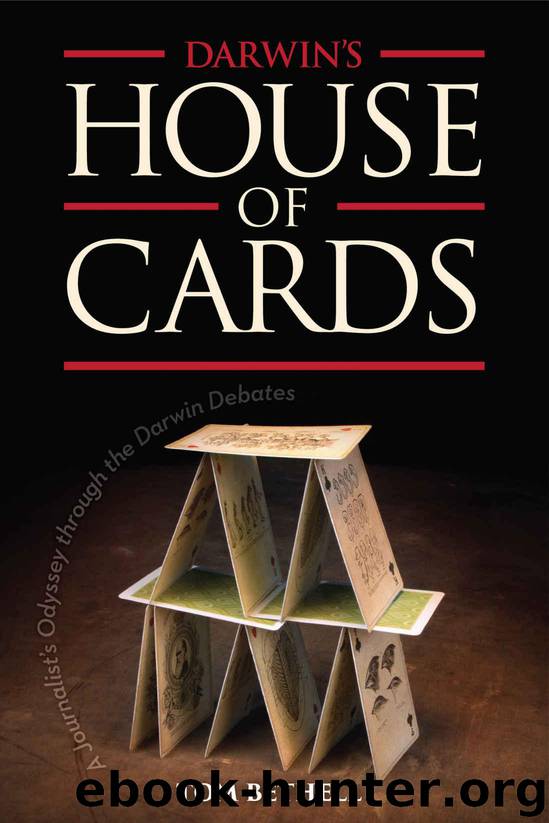Darwin's House of Cards: A Journalist's Odyssey Through the Darwin Debates by Bethell Tom

Author:Bethell, Tom [Bethell, Tom]
Language: eng
Format: azw3, epub
ISBN: 9781936599424
Publisher: Discovery Institute Press
Published: 2017-01-29T16:00:00+00:00
In short, the flagellum resists the standard, Darwin-variety explanation. As it cannot function with a part missing, it is reasonable to infer that it was assembled all at once. And that implies design.
Notice this is not the same as claiming that God created the flagellum, or any other part. Such a conclusion is derived from a theistic premise, where the designer is posited at the outset. Intelligent design theory, then, does not identify a designer, any more than we can identify the designer of Stonehenge.
Complex Specified Information
“IT IS unexceptionable that intelligent causes can do things which unintelligent causes cannot,” said the mathematician and philosopher William Dembski, at the time a Senior Fellow at Discovery Institute.12 In 1996 he published his “explanatory filter,” yielding an inference to design.
The explanatory filter proceeds by eliminating events or structures that cannot be regarded as designed, because they are products either of chance or necessity.
It’s true that “necessary” or law-like events are not designed. Consider a stone that is washed off a cliff. Its landing place can be predicted and its path described mathematically. But its landing place cannot be considered to be “intelligently designed.” It is law-like—a product of gravity and Newton’s laws of motion.
(Some might say that the law of gravity was itself designed by the creator of the universe but that introduces an unnecessary complication that can for our purpose here be ignored.)
Next in the filter we turn to chance. Chance events are obviously not designed. A randomly chosen sequence of say twenty (or more) letters of the alphabet is highly complex, and improbable. It would take a very long time to reproduce it by a random method—by throwing down Scrabble pieces, for example.
But the problem here is that any sequence of twenty letters is as improbable as any other. Improbability alone does not entail design. Every bridge hand ever dealt is improbable, and it would take a dealer a long time to replicate a given hand. But it is erroneous to see something as “designed” merely because reproducing it by random means would be time-consuming.
A random sequence of twenty or so letters or numbers does contain a high level of “information”—but that refers to information as measured by the MIT theorist Claude Shannon. The problem is that Shannon’s theory “cannot distinguish functional or message-bearing sequences from random or useless ones,” as Stephen Meyer said in Signature in the Cell.13 Message-bearing does not appear until a particular sequence is specified. What does that mean? Consider a well-known sequence of letters:
“In the beginning was the word.”
That series of letters and spaces is neither a product of law nor random. It corresponds to a sentence found independently of any procedure for randomly aligning letters. So it is specified. It is also complex. It would take a long time to reach that sequence from St. John’s Gospel by throwing down letters randomly. So it is both complex and specified. From that we can infer that it was designed. Generalizing from this, William Dembski formulated the Law of Small Probability: Specified events of small probability do not occur by chance.
Download
Darwin's House of Cards: A Journalist's Odyssey Through the Darwin Debates by Bethell Tom.epub
This site does not store any files on its server. We only index and link to content provided by other sites. Please contact the content providers to delete copyright contents if any and email us, we'll remove relevant links or contents immediately.
Sapiens: A Brief History of Humankind by Yuval Noah Harari(14320)
Sapiens by Yuval Noah Harari(5322)
Pale Blue Dot by Carl Sagan(4953)
Homo Deus: A Brief History of Tomorrow by Yuval Noah Harari(4871)
Livewired by David Eagleman(3729)
Origin Story: A Big History of Everything by David Christian(3666)
Brief Answers to the Big Questions by Stephen Hawking(3393)
Inferior by Angela Saini(3293)
Origin Story by David Christian(3170)
Signature in the Cell: DNA and the Evidence for Intelligent Design by Stephen C. Meyer(3098)
The Gene: An Intimate History by Siddhartha Mukherjee(3074)
The Evolution of Beauty by Richard O. Prum(2963)
Aliens by Jim Al-Khalili(2803)
How The Mind Works by Steven Pinker(2777)
A Short History of Nearly Everything by Bryson Bill(2659)
Sex at Dawn: The Prehistoric Origins of Modern Sexuality by Ryan Christopher(2500)
From Bacteria to Bach and Back by Daniel C. Dennett(2462)
Endless Forms Most Beautiful by Sean B. Carroll(2443)
Who We Are and How We Got Here by David Reich(2417)
